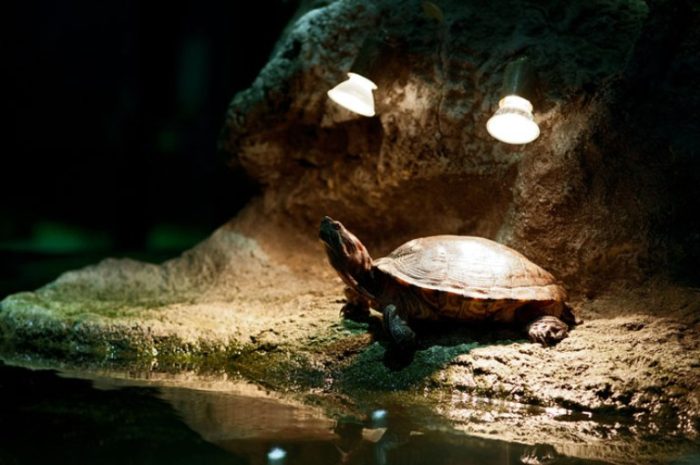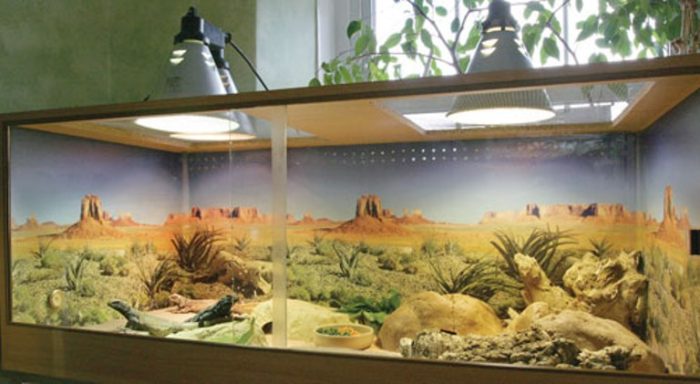A reptile heat lamp is not needed in the wild as nature sees to it that feral reptiles are exposed to the right measure of heat and humidity according to their particular species. These wild creatures are at liberty to choose their dwellings based on their temperature requirements; they navigate to sunny areas when in need of heat and fin a shade when it is time to cool down, if need be, they can even burrow into the ground to cool off.
However, once a reptile is captured and reared in captivity, the onus is now on the pet parent to provide them with the essentials they need to survive; heat and humidity inclusive – this can be provided with a reptile heat lamp. One thing that keepers of reptiles should understand is that these animals are unlike humans as they cannot generate or produce their own body heat; their ectothermic nature means that their body heat can only be obtained from their environment. Thus, providing its habitat with a source of heat should be taken seriously.
Table of Contents
Is It Safe To Leave A Reptile Heat Lamp For Long Hours?
While setting up your reptile’s terrarium, do it in such a way that the temperature will gradually decrease from one extreme to the other. By so doing, your pet reptiles will have enough room to move to the best temperature zone according to their body needs. This kind of environment can be created by locating the heat source on one side of the terrarium. It goes without saying that the side of the enclosure that houses the heat source will stay warmer while the remaining part of the room will be cooler.
Another important thing to remember is that in nature, temperatures tend to drop during the night. Thus, the heating situation should be adjusted in such a way that the ambient temperature becomes cooler during the night than it will be in the daytime. However, you must ensure that the temperature is kept within the appropriate range for your species.
Again, you don’t just provide your reptiles with light and leave them alone, the temperature must be monitored at all times to ensure that it is where it’s meant to be.
The easiest way to keep tabs on the temperature in a terrarium is to equip each end of the room with an adhesive temperature strip. With this, you will be able to constantly monitor the temperature at both the coolest and warmest ends of the enclosure. You will now be in a better position to extrapolate the temperature ranges in-between both ends. For the same purpose, a digital thermometer with probes can be used.
Reptiles from the tropics need both heat and humidity, and in this case, pet parents need to acquire a dual thermometer in addition to a humidity gauge. This device will tell you when humidity needs to be increased in the enclosure.
Are Reptile Heat Lamps Safe For Your Pet?
From what we have discussed so far, it is obvious that caged reptiles need heat lamps to survive. However, keepers should ensure that they follow all the safety tips that accompany those heating devices. Again, pet parents should understand the species of reptiles they keep; this will provide a guide on the measure of heat and humidity they need to provide for their survival.
Thus, it is absolutely safe to use a reptile heat lamp but caution needs to be applied to get the best out of the device and ensure the safety of your pet.
Reptiles That Need Heat Lamps

- Corn snake
In a day, pet parents who keep corn snakes should provide them with 8 to 12 hours of light; the white light should never be left on at all times; during the night, it is best to use infrared or nocturnal light.
- Leopard gecko
Leopard geckos should be provided with 10 to 12 hours of light on a daily basis. Thanks to their nocturnal nature, the reptile doesn’t require UVB lighting. During the day, the reptile can bask under an incandescent bulb; a nocturnal heat bulb or ceramic heater can be used throughout the day.
- Russian tortoise
Your pet Russian tortoise would need UVB lighting for 12 to 14 hours daily.
- Bearded dragon
UVB rays equipped with full-spectrum lighting can be provided for 10 to 12 hours a day. During the day, your bearded dragon can crawl under an incandescent day bulb, and all day long, a nocturnal bulb or ceramic heater can be used.
- Ball python
About 8 to 12 hours of light should do for a ball python daily. Never leave the white light on continuously; an infrared or nocturnal light should be used at night.
Important to note that not all reptiles need the same quantity of light; they need light in different degrees, depending on the species. Desert reptiles like leopard geckos and bearded dragons, and tropics-based ones like green iguanas, anoles, and Chinese water dragons would need to be provided with more warmth. On the other hand, temperate region reptiles such as corn snakes and skinks would need less warmth. While we agree that all reptiles thrive in a warm environment, the tropical and desert region reptiles are happiest when provided with higher temperatures to bask in as opposed to their temperate climes cousins.
Read Also: 40 Gallon Reptile Tank – What Do You Need It For?
Safety Tips To Apply When Using Heat Lamps For Reptiles
- When buying heating elements such as lamps, extension cords, and other related products, be sure to carefully follow all attached safety instructions.
- When using hoods with heat lamps, ensure that they are rated for the wattage of the bulb. For instance, a hood rated for 120 watts max cannot be a good fit for a 200-watt bulb.
- Heating devices should be kept out of direct contact with inflammable materials like fabrics, paper, wood, and the likes.
- Owners who have a large collection of reptiles with multiple cages and heating devices should consider acquiring a small-sized fire extinguisher which should be kept permanently in the reptile room.
- The wall outlets should never be overloaded with electrical devices.
- Always make use of timers for your heating devices; with this, you can know when to turn them off even if it may be just for a few hours daily. By so doing, your reptiles will have ample chance to cool down. The timer is not just a safety technique; it also functions in prolonging the life of both heating devices and bulbs.
- Avoid using worn-out or broken heat lamps. Always discard and replace loose light fixtures, frayed electrical wires, and damaged heat pads.
- Always use your common sense to decipher things that are workable and those that are not. Anything that doesn’t appear to be a good idea is probably not.
